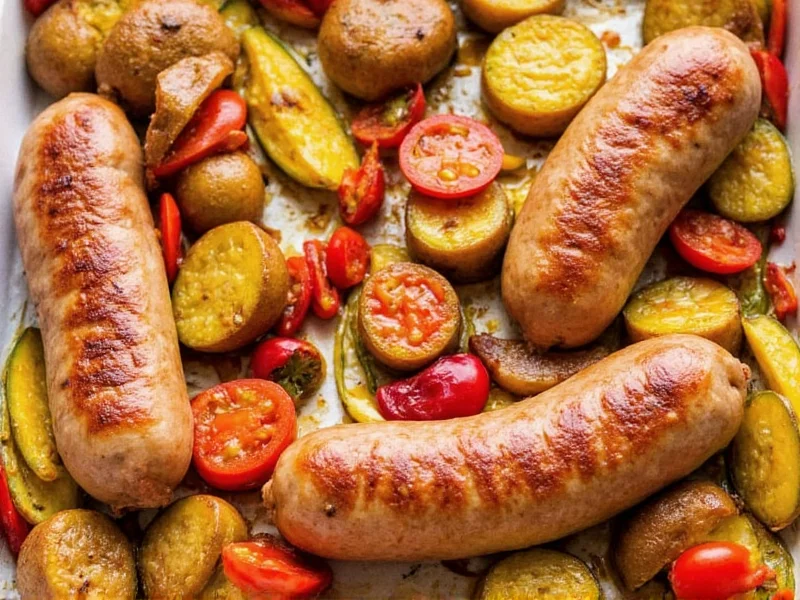Creating the perfect sheet pan sausage and vegetables meal is simpler than most home cooks realize. This one-pan wonder combines protein-rich sausage with roasted vegetables for a balanced, flavorful dinner ready in under 30 minutes. The magic happens when quality ingredients meet proper technique: selecting the right sausage variety, cutting vegetables to uniform sizes, and arranging everything correctly on the baking sheet. Unlike complicated recipes, this approach maximizes flavor through caramelization while minimizing cleanup—making it ideal for busy weeknights or meal prep Sundays.
What sets an exceptional sheet pan sausage dinner apart from mediocre attempts? The secret lies in understanding three critical elements: sausage selection, vegetable preparation, and oven management. Many home cooks make the mistake of overcrowding the pan or using inappropriate sausage types, leading to steamed rather than roasted results. By following these evidence-based techniques, you'll achieve restaurant-quality caramelization without special equipment.
Essential Ingredients for Perfect Results
| Ingredient | Quantity | Preparation Notes |
|---|---|---|
| Italian sausage links | 1.5 lbs | Choose mild or hot depending on preference; remove casings for crumbled version |
| Broccoli florets | 3 cups | Cut to 1.5-inch pieces for even cooking |
| Red bell peppers | 2 medium | Sliced into 1-inch strips |
| Red potatoes | 1.5 lbs | Cubed to 3/4-inch pieces (parboil 5 minutes for crisp-tender results) |
| Olive oil | 3 tbsp | Extra virgin for best flavor |
| Garlic powder | 1.5 tsp | Fresh minced garlic burns easily at high heat |
Step-by-Step Cooking Instructions
- Prep vegetables properly: Cut dense vegetables like potatoes smaller than softer ones like zucchini. Parboil potatoes for 5 minutes to ensure even cooking with sausage.
- Season strategically: Toss vegetables with 2 tablespoons oil, garlic powder, 1 teaspoon salt, and 1/2 teaspoon black pepper. Reserve 1 tablespoon oil for sausage.
- Arrange correctly: Spread vegetables in a single layer on a rimmed baking sheet lined with parchment paper. Place sausage links on top, spacing them evenly.
- Roast at optimal temperature: Bake at 400°F (205°C) for 20-25 minutes, flipping sausage and stirring vegetables halfway through.
- Finish with freshness: Remove from oven when sausage reaches 160°F internally and vegetables show golden brown edges. Squeeze fresh lemon juice over finished dish.
Proven Techniques for Better Results
Avoid the most common sheet pan sausage mistake: overcrowding. When ingredients touch, they steam instead of roast. Use two pans if necessary—this applies whether you're making sheet pan sausage and peppers or experimenting with root vegetables. For crispier sausage, pat links dry before roasting and avoid piercing casings prematurely.
Timing matters significantly in one pan sausage and vegetable recipes. Add delicate vegetables like cherry tomatoes during the last 10 minutes of cooking. For meal prep friendly versions, choose vegetables that reheat well like Brussels sprouts rather than zucchini which becomes mushy.
Variations for Different Dietary Needs
Adapt this basic sheet pan sausage dinner framework to accommodate various preferences. For paleo diets, substitute sweet potatoes and use sugar-free sausage. Vegetarians can create a satisfying alternative with plant-based sausage links and extra mushrooms. When preparing sheet pan sausage for kids, reduce spices and include familiar vegetables like carrots cut into coins.
Global flavor variations transform this basic recipe: add smoked paprika and white beans for Spanish-inspired dishes, or toss with soy-ginger marinade for an Asian twist. The best sausage for sheet pan cooking depends on your flavor profile—chorizo works well with potatoes, while chicken apple sausage pairs beautifully with autumn vegetables.
Storage and Reheating Guidelines
Properly stored sheet pan sausage and vegetables maintain quality for 3-4 days in airtight containers. Separate sausage from vegetables when storing to prevent sogginess. Reheat in a 350°F oven for 10-15 minutes rather than microwaving, which makes vegetables limp. For meal prep efficiency, divide portions immediately after cooking while ingredients are still hot.
Frequently Asked Questions
What's the best sausage for sheet pan cooking?
Italian sausage provides ideal fat content and seasoning for roasting, but kielbasa works well with root vegetables. Avoid heavily smoked varieties which can overpower other ingredients. For leaner options, choose chicken or turkey sausage but increase oil slightly to compensate for lower fat content.
How do I prevent vegetables from burning?
Cut dense vegetables smaller than softer ones, and parboil potatoes or carrots for 5 minutes before roasting. Toss vegetables in oil thoroughly but don't overcrowd the pan. Check at the 15-minute mark and cover delicate items like cherry tomatoes with foil if browning too quickly.
Can I cook sheet pan sausage and vegetables at 375°F instead?
Yes, but extend cooking time to 30-35 minutes. Lower temperatures require longer roasting which can lead to drier sausage. If using 375°F, place sausage on a separate rack above vegetables to catch drippings, or start at 400°F for 15 minutes then reduce heat.
Why does my sheet pan sausage turn out dry?
Overcooking is the primary culprit. Remove sausage when it reaches 160°F internally—it will continue cooking from residual heat. Using lean sausage varieties without sufficient fat also causes dryness. For juicier results, choose pork-based sausages with 20-30% fat content and avoid piercing casings until the final cooking stage.











 浙公网安备
33010002000092号
浙公网安备
33010002000092号 浙B2-20120091-4
浙B2-20120091-4